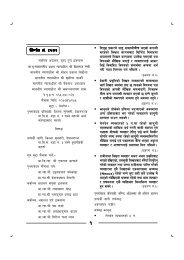The Nepali Judiciary - Supreme Court Of Nepal
The Nepali Judiciary - Supreme Court Of Nepal
The Nepali Judiciary - Supreme Court Of Nepal
You also want an ePaper? Increase the reach of your titles
YUMPU automatically turns print PDFs into web optimized ePapers that Google loves.
<strong>Supreme</strong> <strong>Court</strong>, <strong>Nepal</strong><br />
Preface<br />
B<br />
Min Bahadur Rayamajhi<br />
Chief Justice<br />
With the expiry of the execution of the First Five-Year Plan of the <strong><strong>Nepal</strong>i</strong> <strong>Judiciary</strong>, a Second Fiver-Year<br />
Strategic Plan for the year 2009/10-2013/14 has been formulated and it gives me immense pleasure to state<br />
that the Second Five-Year Plan is in the process of being published for the purpose of its implementation.<br />
For the purpose of bringing about reforms in the judiciary, the strategic plan in itself is a novel practice.<br />
Although, the vision, mission and values envisaged by the strategic plan for the judiciary are generally static<br />
in nature, it is but natural for the judiciary to adapt itself pursuant to the changing context and as such the<br />
responsibilities and its subsequent activities and strategies to be applied need to be amended as per the<br />
prevailing circumstances. I have found that the Second Five-Year Strategic Plan has been able to address<br />
those changes. <strong>The</strong> Plan is a document directed towards reformation of the judiciary. I would like to<br />
emphasis that each level of the judiciary and units shall taken on the responsibility and shall formulate their<br />
individual work plans and shall work towards attaining the objectives envisaged by the Plan.<br />
All our activities should now be focused on the effective execution of the Plan. <strong>The</strong> First Five-Year Strategic<br />
Plan of the judiciary was a first attempt of the judiciary and the lacunas and weaknesses that were<br />
experienced during its execution should not be experienced during the execution of the second Plan. <strong>The</strong><br />
achievements derived from the execution of the first Plan should be institutionalized and with our previous<br />
experience, we should be able to identify the path for effective execution of the second Plan. <strong>The</strong> touchstone<br />
of successful execution of the Plan is the satisfaction of the court users. We should endeavor towards<br />
creating an environment that guarantees satisfaction to the court users.<br />
<strong>The</strong> principal objective of the judiciary is to generate public trust upon the judiciary. For the promotion of<br />
public trust upon the judiciary, the Plan should address the expectations of the court users and for this<br />
purpose the judiciary through its Plan has brought forward reform activities. Nevertheless, it is not possible<br />
for the court to single handedly implement the Plan and in this regard the Plan expects creative cooperation<br />
from the principal organs of the State vis-à-vis the Executive, Legislative, other units of the State,<br />
investigation and prosecution party, legal professionals, civil society, court users and other relevant<br />
stakeholders. In order to enhance ownership towards the Plan, participation of relevant stakeholders were<br />
made during the formulation of the Plan and I am confident that all parties shall provide assistance towards<br />
the execution of the Plan.<br />
This journey towards a planned development will not only make us committed towards our campaigns of<br />
judicial reform but the Plan has also prescribed the standard for retrospection. <strong>The</strong>refore, this journey should<br />
not be stopped and being influenced by the principle that this should receive continuity, the Second Plan has<br />
been formulated prior to the expiry of the period of the first Plan. Human resources of the judiciary have been<br />
used in preparation of the second Plan. <strong>The</strong> development of enhanced human resources within the judiciary<br />
in the preparation of the Plan is a matter of pride for all of us. I am confident that the human resources within<br />
the judiciary and the concerned stakeholders shall from their respective sectors remain committed towards<br />
the successful implementation of the Plan and I would like to convey my gratitude to all the honorable<br />
justices and staff who were involved in the formulation of the Strategic Plan and I wish the Plan all success.<br />
.........................................<br />
Min Bahadur Rayamajhi<br />
<strong>Supreme</strong> <strong>Court</strong> Chief Justice<br />
Shrawan 2066<br />
Ramshah Path, Kathmandu, <strong>Nepal</strong>, Telephone No. 977-1-4262546, Fax No: 977-1-4216864,Post Box No. 20438<br />
Baluwatar (Residence) 977-1-4410363




![lg0f{o g+=&(&# g]=sf=k= @)^% ;af]{Rr cbfnt ljz]if Ohnf; ;DdfggLo k ...](https://img.yumpu.com/10045627/1/190x245/lg0fo-g-gsfk-afrr-cbfnt-ljzif-ohnf-ddfgglo-k-.jpg?quality=85)
![lg0f{o g+=&(@% g]=sf=k= @)^% ;jf]{Rr cbfnt, ljz]if Ohnf; dfggLo ...](https://img.yumpu.com/6479513/1/190x245/lg0fo-g-gsfk-jfrr-cbfnt-ljzif-ohnf-dfgglo-.jpg?quality=85)

![lgj]b s ljkIfL - Supreme Court Of Nepal](https://img.yumpu.com/5482729/1/190x245/lgjb-s-ljkifl-supreme-court-of-nepal.jpg?quality=85)